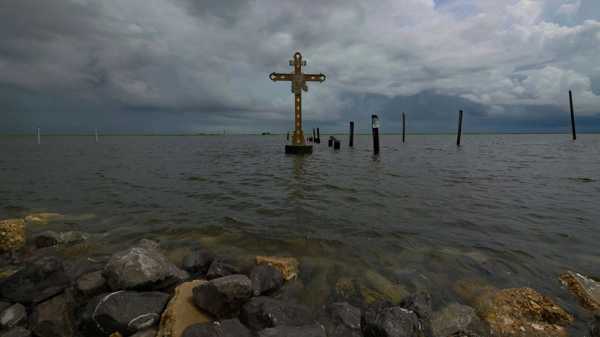
Hurricanes in the U.S. the last few decades killed thousands more people than meteorologists traditionally calculate and a disproportionate number of those victims are poor, vulnerable and minorities, according to a new epidemiological study.
A team of public health and storm experts calculated that from 1988 to 2019 more than 18,000 people likely died, mostly indirectly, because of hurricanes and lesser tropical cyclones in the continental United States. That's 13 times more than the 1,385 people directly killed by storms that the National Oceanic and Atmospheric Administration figures, but the study authors said those numbers aren't directly comparable.
Instead of just looking at people who drowned, were hit by debris or killed directly by the storm, the study in Wednesday's journal Science Advances examines changes in a storm-hit county’s overall number of deaths just before, during and after a hurricane and compared those to normal years. Researchers attributed the excess deaths to the storm, using a standard public health technique.
“It’s the difference between how many people died and how many people would have died on a normal day” with no hurricane, said study lead author Robbie Parks, an environmental epidemiologist at Columbia University’s Mailman School of Public Health.
After a storm, deaths spike because of heart and lung problems, infections, injury and mental health issues, Parks said. It’s a stressful time with clean-up and rebuilding.
Parks said meteorologists do an admirable job counting people killed during the height of the storm, but so many people die indirectly and especially after the storm, he said “it does seem to be an undercount" that misses the poorest and most vulnerable Americans.
“People who have the least means suffer the most,” said study lead author Robbie Parks, an environmental epidemiologist at Mailman. “It’s a good opportunity to put a number on that.”
Using the Centers of Disease Control and Prevention’s social vulnerability index, Parks divided American counties into the least vulnerable third, the most vulnerable third and the middle, categories that often correlate with the richest, poorest and middle income people. In the case of the heaviest hurricane winds, the most vulnerable third had 57% of the excess deaths and least vulnerable had 6%.
“Conceptually the results of the study make sense, as tropical cyclones often leave communities vulnerable for long periods of time after impact,” National Hurricane Center Director Michael Brennan said in an email.
The hurricane center has noticed this when their experts study storm sites, so the center is trying to increase community engagement to more socially vulnerable populations and expand translation of storm warnings into other languages, Brennan said.
“It does not surprise me, but deeply saddens me that excess mortality is largest among the most vulnerable segments of our population,” said MIT hurricane scientist Kerry Emanuel, who wasn’t part of the study. “It is the poorer people with fewer places to evacuate to and fewer means to get out who take the brunt of the suffering.”
After a storm, people need to have money “to do more than just survive from day to day,” which is why the poorer, more vulnerable survive less, said former NOAA hurricane scientist Jim Kossin of the climate risk nonprofit First Street Foundation, who also was not part of the study.
Finding out how many people are really killed because of a storm is much more challenging to quantify than merely counting direct deaths reported in the media, Kossin said.
For example, the National Hurricane Center estimates that 1,200 people died in 2005’s Hurricane Katrina, but using deaths before, during and after and comparing them to 30 years of normal death rates for those places at that time of year, Parks and colleagues figured a death count of 1,491.
Parks’ team found bigger gaps between official death counts and what they calculated for 2012’s Superstorm Sandy, where the hurricane center said 147 people died. Parks put the death toll at 1,193. And the largest gap was for 2017’s Irma, where NOAA said 92 people died directly or indirectly in the United States, while Parks counted 1,202.
The National Hurricane Center's Brennan said his agency writes official reports on storms that use fatality statistics based on information from government officials, medical examiners and the media within several months of landfall. The center doesn't have access to the longer-term statistical studies used to calculate “indirect” deaths, but tries to bring them in when able, such as in the case of 2005's Katrina and 2017's Maria.
In a separate report for the American Meteorological Society, the National Hurricane Center analyzed how people died in direct hurricane deaths the last 10 years and compared them to earlier. It found that a much lower percentage of people are being killed by storm surge, but a higher percentage of Americans are dying in freshwater flooding.
From 1963 to 2012, storm surge was responsible for almost half of the hurricane deaths. NOAA has made a concerted effort to improve storm surge forecasts, warning and education of residents on the coast. Since 2013, only 11% of the hurricane deaths were storm-surge related, the hurricane center said.
But freshwater flooding deaths went from 27% of the deaths to 57% of all hurricane deaths, a figure that may be skewed by 2017's Hurricane Harvey, when there 65 freshwater flooding deaths. Rip current and surf deaths went from 6% of the hurricane deaths to 15%.
___
Follow AP’s climate and environment coverage at https://apnews.com/hub/climate-and-environment
___
Follow Seth Borenstein on Twitter at @borenbears
___
Associated Press climate and environmental coverage receives support from several private foundations. See more about AP’s climate initiative here. The AP is solely responsible for all content.
Sourse: abcnews.go.com





